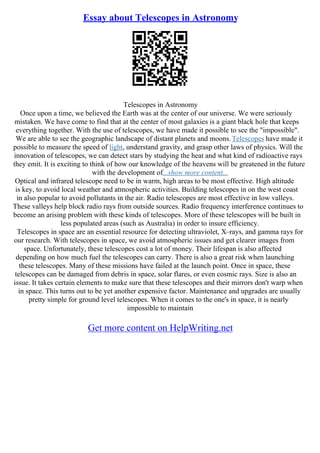The student reflects on taking an astronomy course, finding the material beyond the first exam more challenging and conceptually difficult, but also more rewarding. They enjoyed learning about telescopes, the Earth and moon, solar system formation, and the seasons. The student looks forward to continuing their study of increasingly complex astronomical concepts.







![History of Astronomy
HISTORY OF ASTRONOMY
Astronomy is the oldest of the natural sciences, dating back to antiquity, with its origins in the
religious, mythological, and astrological practices of pre–history: vestiges of these are still found in
astrology, a discipline long interwoven with public and governmental astronomy, and not completely
disentangled from it until a few centuries ago in the Western World . In some cultures astronomical
data was used for astrological prognostication.
Ancient astronomers were able to differentiate between stars and planets, as stars remain relatively
fixed over the centuries while planets will move an appreciable amount during a comparatively short
time.
Early history
Early cultures identified celestial objects with...show more content...
The original mechanism is displayed in the Bronze collection of the National Archaeological
Museum of Athens, accompanied by a replica. India
Ancient Indian astrology is based upon sidereal calculation. The sidereal astronomy is based upon
the stars and the sidereal period is the time that it takes the object to make one full orbit around the
Sun, relative to the stars. It can be traced to the final centuries BC with the Vedanga Jyotisha
attributed to Lagadha, one of the circum–Vedic texts, which describes rules for tracking the motions
of the Sun and the Moon for the purposes of ritual. After formation of Indo–Greekkingdoms, Indian
astronomy was influenced by Hellenistic astronomy (adopting the zodiacal signs or rДЃЕ›is).
Identical numerical computations for lunar cycles have been found to be used in India and in early
Babylonian texts.[11]
Astronomy was advanced during the Sunga Empire and many star catalogues were produced during
this time. The Sunga period is known as the "Golden age of astronomy in India".
China
The astronomy of East Asia began in China. Solar term was completed in Warring States Period. The
knowledge of Chinese astronomy was introduced into East Asia.
Astronomy in China has a long history. Detailed records of astronomical observations were kept
from about the 6th century BC,
Get more content on HelpWriting.net](https://image.slidesharecdn.com/astronomyessay-230610113429-94011dfc/85/Astronomy-Essay-8-320.jpg)













